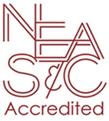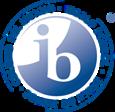School
2024-25




School
2024-25



The International Baccalaureate© aims to develop inquiring, knowledgeable and caring young people who help to create a better and more peaceful world through intercultural understanding and respect
To this end, the organisation works with schools, governments and international organisations to develop challenging programmes of international education and rigorous assessment
These programmes encourage students across the world to become active, compassionate and lifelong learners who understand that other people, with their differences, can also be right (IB mission statement)
The International School of Paris (ISP) is committed to delivering the International Baccalaureate (IB) Programmes In the Primary School, the Primary Years Programme (PYP) is followed from Nursery to Grade 5
The ISP High Quality Learning Definition
High quality learning is a social and experiential practice. It sparks students’ curiosity and stimulates their natural creativity. It inspires them to strive for excellence, and to take ownership of their own inquiry and research. It shapes the learner and the learning community, nurturing growth and new understandings.
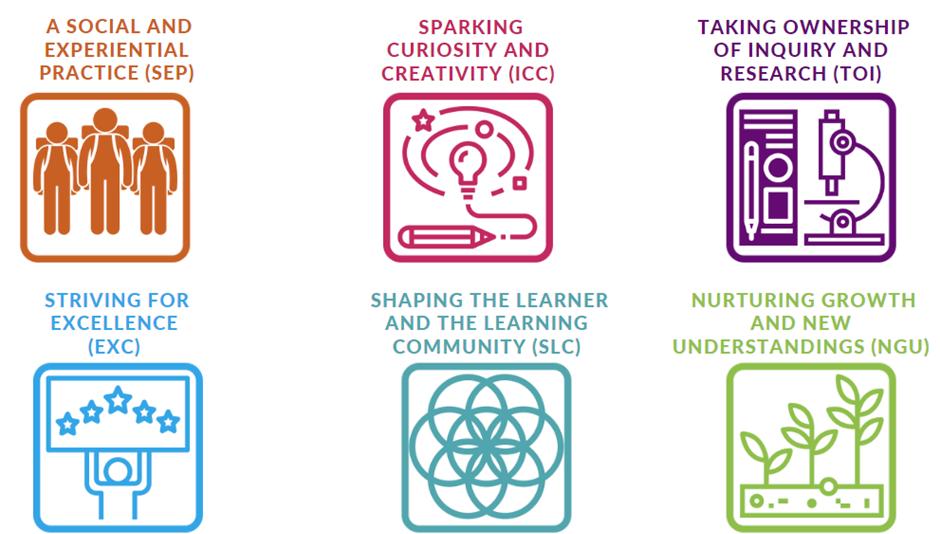


The PYP curriculum framework emphasises the central principle of agency that is threaded throughout the three pillars of the curriculum: the learner, learning and teaching and the learning community Augmenting the focus of the “written, taught, and assessed” curriculum with the human elements the learner and the learning community underlines that everyone connected to the school community has voice, choice and ownership to impact learning and teaching. These holistic components complement and reinforce each other to form a coherent whole.
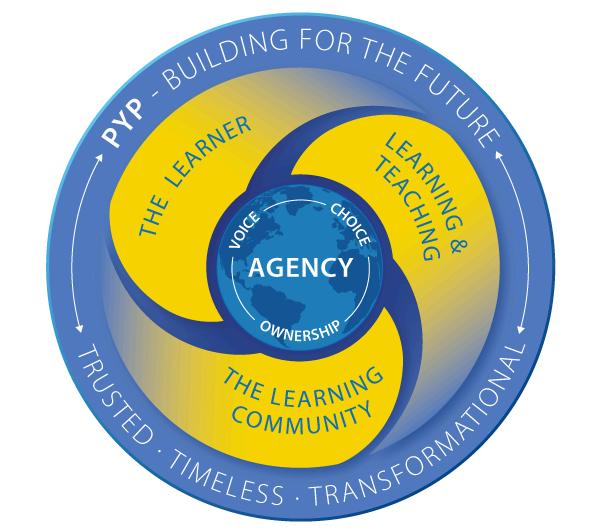
The learner: describes the outcomes for individual students and the outcomes they seek for themselves (what is learning?).
Learning and teaching: articulates the distinctive features of learning and teaching (how best to support learners?)
The learning community: emphasises the importance of the social outcomes of learning and the role that IB communities play in achieving these outcomes (who facilitates learning and teaching?).

The Primary School sets out to meet the diverse needs of the students through the Primary Years Programme, by ensuring that learning is engaging, relevant, challenging and significant The school follows a transdisciplinary model, whereby themes of global significance frame the learning throughout the primary years, including early childhood This means that students are encouraged to make connections between subject areas, and traditional curriculum areas are used as lenses to help students inquire into big ideas
The PYP is both a curriculum framework and a philosophy that facilitates structured inquiry Through inquiry, the students are encouraged to question, wonder, doubt, speculate and generalise as part of their learning journey to construct meaning about the world around them Students have the opportunity to explore significant local and global issues and are also encouraged to consider situations critically from multiple viewpoints.
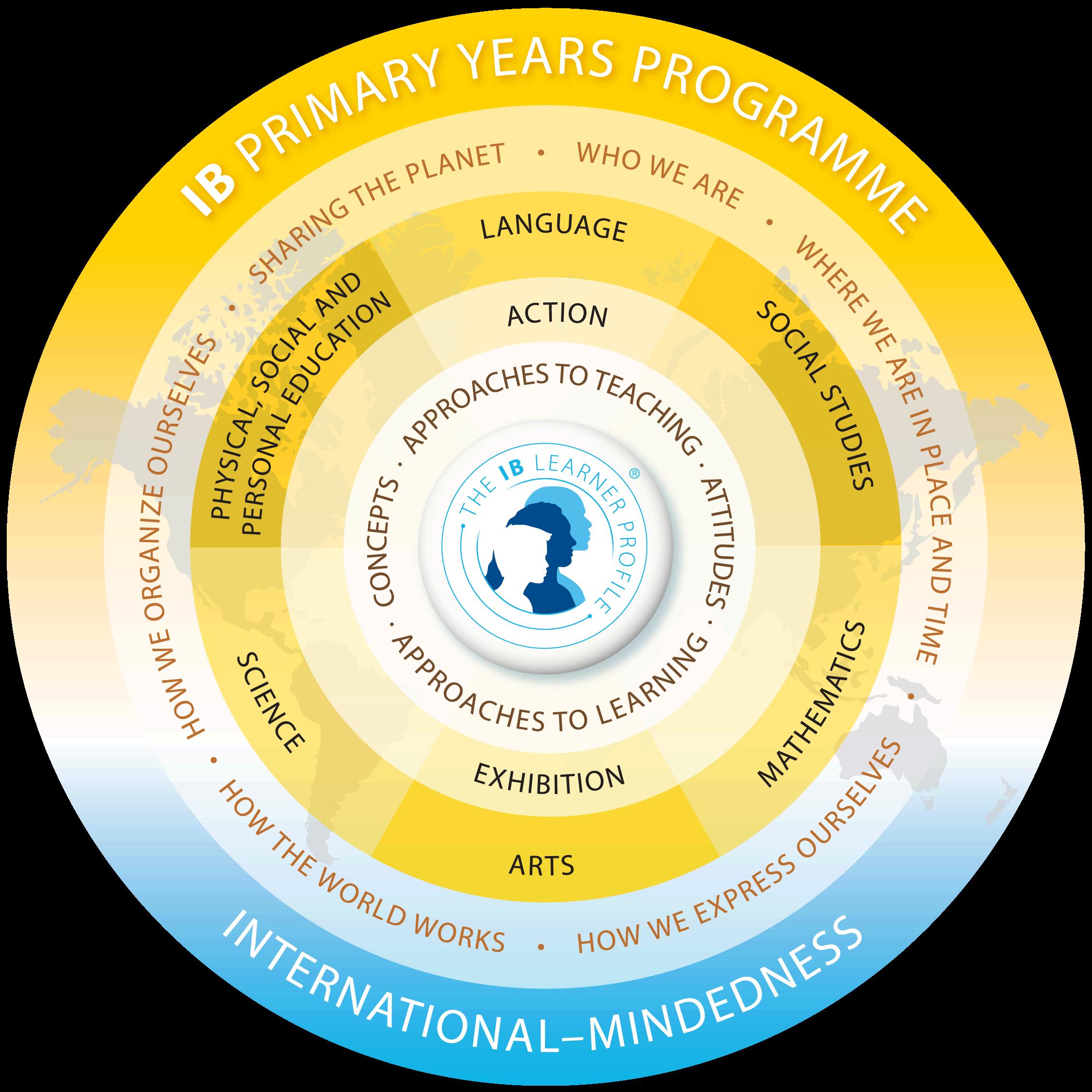
In the Primary School, opportunities to share experiences between students, parents and teachers are a critical element in developing a sense of international mindedness This begins with each student’s ability to develop a sense of personal and community identity We encourage all members of our community to share their personal histories as well as their cultural identities In gaining an appreciation of themselves, the students are then exposed to other cultures, making use of our diverse student population With this in mind, celebrations of our diverse cultures are encouraged throughout the Primary School We invite students, their families and friends to lead these events, whether it is reading stories to students in English or in another language, sharing food or celebrating festivals. We will reach out to the community for support prior to these events. We also hold an international event once a year, in which parent participation is essential. This is one of the highlights of the year for our community, bringing students, staff and parents together to celebrate our uniqueness.
The PYP encourages students to become independent learners, and ISP encourages them to make connections between life in school, life at home and life in the world. By helping students to see that learning is connected to life, a strong foundation for future learning is established.
Our understanding of the learner is the foundation of our approach to learning and teaching. Children inquire, question, wonder and theorise about themselves, others and the world around them They are keen observers and explorers Through their experiences and interactions, they naturally develop intricate, multi-layered perceptions and understandings Throughout the PYP, a student is an agent for their own and others’ learning through the concept of learner agency Learner agency is connected to a student’s belief in their ability to succeed (self-efficacy)
Conceptualised by Albert Bandura in social cognitive theory, agency “enable[s] people to play a part in their self-development, adaptation, and self-renewal with changing times” (Bandura 2001) PYP students with agency use their own initiative and will, and take responsibility and ownership of their learning. They direct their learning with a strong sense of identity and self-belief, and in conjunction with others, thereby building a sense of community and awareness of the opinions, values and needs of others.
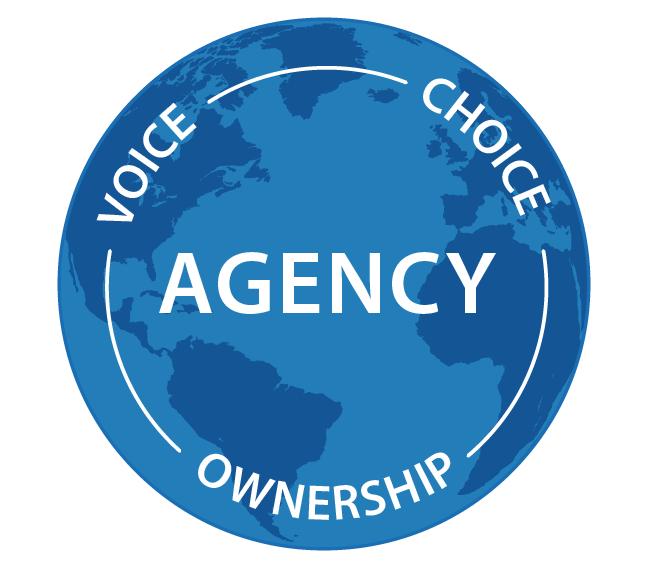
When learners have agency, the role of the teacher and student changes; the relationship between a teacher and student is viewed as a partnership


When teachers acknowledge learner agency and the importance of self-efficacy, students become partners in the learning process In this partnership, teachers work alongside students, meet with small groups and individuals as needed, and monitor learning and provide feedback
Students demonstrate agency when they:
● influence and direct their own learning;
● make choices;
● voice opinions;
● ask questions and express wonderings;
● communicate understandings;
● construct new meanings;
● participate in and contribute to the learning community.
How teachers at ISP support agency
● Students learn by doing. Teachers create opportunities for agency in the classroom by involving students in the following activities:
o Establishing a respectful and welcoming culture Collaborate with students to create shared agreements about how to interact with others to create a culture of respect and trust where all students feel welcomed, significant and emotionally safe.
o Creating shared routines. Ask for students’ input into developing routines around arrival, transitions, communication signals, meetings, clean-up and dismissal
o Setting up the learning spaces. Ask students to help set up and arrange learning spaces that make them feel safe physically and where they can access learning materials, make choices and take risks
o Making decisions about learning Involve students in making decisions about what, why and how they learn as co-collaborators in the learning community. Allow time to respond to students’ ideas about action.
o Communicating expectations Clarify what knowledge, conceptual understandings, skills and dispositions the students are learning, and why.


The IB learner profile are ten personal attributes valued by IB World Schools. We believe these attributes help our students become responsible members of local, national and global communities. The learner profile is what enables ISP to reach its mission, Educating for Complexity. The attributes of the learner profile permeate teaching and learning and provide a framework for our values

Effective teaching, Albright (2016: 532) believes, “is implicitly transdisciplinary”, and, by design, multiple elements of the PYP bring to life transdisciplinary learning and teaching These elements provide the foundation for students to develop transdisciplinary thinking, to explore real-life issues and to effect change They support the development of “internationally minded people who recognize their common humanity and shared guardianship of the planet” (IBO 2017: 2)

The PYP curriculum framework centres on transdisciplinary learning as the curriculum organiser for students to experience learning between, across and beyond traditional subject boundaries It is an in-depth guide to authentic inquiry-based learning and teaching that is engaging, significant, challenging and relevant
PYP schools strive towards deeper implementation of transdisciplinary learning in their curriculums and communities by committing to a foundational set of principles found in Programme Standards and Practices (PSP) These foundational principles ensure quality and fidelity in the implementation of all IB programmes at IB World Schools
The PYP curriculum framework and the PSP framework work in conjunction to provide schools with the guidance needed to meet the quality standard of a PYP programme, and to encourage schools to develop and improve programmes that fit their contexts and educational aims. As schools use the

PYP curriculum framework to organise their curriculums and communities, they can use the PSP framework to develop the environment, culture, policies and processes that support effective practice and exemplify the IB mission.
The transformative nature of the PYP lies in its commitment to student learning in a transdisciplinary context, embedded in the curriculum framework and connected across key elements of the programme. It is a fundamental PYP belief that for early and primary years learners, continuous integration and connection of prior and new knowledge and experiences is the most meaningful way to broaden their understanding of the world. “When a curriculum approach goes across, between and beyond subjects, and emphasises participatory and integrated learning, it honours the learners’ curiosity, questions and voice, for whom the curriculum is intended” (Beane 1995) Transdisciplinary learning in the PYP refers to learning that is not confined within traditional subjects but is supported and enriched by them
The transdisciplinary themes mark the starting point of student inquiries It is within the context of each theme that students explore related central ideas and assimilate knowledge These themes engage the learning community in rich dialogues and ongoing collaboration to build an understanding of themselves, their wider community and the world Designed to have enduring value regardless of the geography or background of IB World Schools and students, the six themes provide guidance for what students will inquire into They:
● encapsulate our shared commonalities;
● indicate the complexity and the connectedness of the human condition globally;
● invite students to engage in dialogues about real issues in the world;
● allow for authentic embeddedness of subject areas;
● contribute to the uniqueness of the PYP.

Who we are
Where we are in place and time
Descriptions
An inquiry into the nature of the self; beliefs and values; personal, physical, mental, social and spiritual health; human relationships including families, friends, communities and cultures; rights and responsibilities; what it means to be human.
An inquiry into orientation in place and time; personal histories; homes and journeys; the discoveries, explorations and migrations of humankind; the relationships between, and the interconnectedness of, individuals and civilizations from local and global perspectives.
How we express ourselves
How the world works
How we organise ourselves
An inquiry into the ways in which we discover and express ideas, feelings, nature, culture, beliefs and values; the ways in which we reflect on, extend and enjoy our creativity; our appreciation of the aesthetic.
An inquiry into the natural world and its laws; the interaction between the natural world (physical and biological) and human societies; how humans use their understanding of scientific principles; the impact of scientific and technological advances on society and on the environment.
An inquiry into the interconnectedness of human-made systems and communities; the structure and function of organisations; societal decision-making; economic activities and their impact on humankind and the environment
Sharing the planet
An inquiry into rights and responsibilities in the struggle to share finite resources with other people and with other living things; communities and the relationships within and between them; access to equal opportunities; peace and conflict resolution

A concept-driven curriculum
Concept-based inquiry is a powerful vehicle for learning that promotes meaning and understanding, and challenges students to engage with significant ideas This is central to the Primary Years Programme (PYP) philosophy “Purposeful inquiry is supported by a concept-driven curriculum” (Wiggins, McTighe 2005)
A concept-driven curriculum is the means through which students develop their conceptual understandings Students co-construct beliefs and mental models about how the world works based on their experiences and prior learning They integrate new knowledge with their existing knowledge and apply these understandings in a variety of new contexts They learn to recognize patterns and see the connections between discrete examples to strengthen conceptual understandings
“A concept is a ‘big idea’ a principle or notion that is enduring and is not constrained by a particular origin, subject matter or place in time” (Erickson 2008). Concepts represent ideas that are broad, abstract, timeless and universal. Concepts add depth and rigour in student thinking to the traditional ‘two-dimensional’ curriculum consisting of facts and skills. Concepts place no limits on breadth of knowledge or on depth of understanding, and therefore are accessible to every student.
Concepts help to:
● explore the essence of a subject
● add coherence to the curriculum
● deepen disciplinary understanding
● build the capacity to engage with complex ideas
● build understandings across, between and beyond subjects
● integrate and transfer learning to new contexts
Concepts are powerful, broad and abstract organising ideas that may be transdisciplinary or subject-based They represent the vehicle for students’ inquiry into the opportunities and challenges of local and global significance Concepts are concise; they are usually represented by one or two words
In the PYP there are seven specified concepts that facilitate planning for a conceptual approach to transdisciplinary and subject-specific learning Together, these specified concepts form the component that drives the teacher- and/or student-constructed inquiries that lie at the heart of the PYP curriculum

Form What is it like?
Function How does it work?
Causation Why is it as it is?
Change How is it transforming?
Connection How is it linked to other things?
Perspective What are the points of view?
The understanding that everything has a form with recognizable features that can be observed, identified, described and categorised
The understanding that everything has a purpose, a role or a way of behaving that can be investigated
The understanding that things do not just happen; there are causal relationships at work, and that actions have consequences
The understanding that change is the process of movement from one state to another. It is universal and inevitable.
The understanding that we live in a world of interacting systems in which the actions of any individual element affect others.
The understanding that knowledge is moderated by different points of view which lead to different interpretations, understandings and findings; perspectives may be individual, group, cultural or subject-specific.
Responsibility What are our obligations?
The understanding that people make choices based on their understandings, beliefs and values, and the actions they take as a result do make a difference
Specified concepts drive learning experiences and help to frame a unit of inquiry By identifying and investigating specified concepts, students learn to think critically about big ideas This may be done through broad, open-ended questions in an inquiry When concepts are viewed as a set of questions, the inquiry is directed, purposeful and manageable
The questions associated with the specified concepts in the table are a starting point They represent an introduction to a way of thinking about learning and teaching They can be used in any order and as regularly as the students and teachers require There can be more than one concept in an inquiry In collaboration with students, teachers identify and document the most relevant specified concepts in each unit While the seven concepts have been identified in the curriculum framework, they are not the only concepts worth exploring, and schools are encouraged to add to this list.

Approaches to learning (ATLs) are an integral part of an IB education and complement the learner profile, knowledge, conceptual understanding and inquiry
These skills are grounded in the belief that learning how to learn is fundamental to a student’s education Five categories of interrelated skills aim to support students of all ages to become self-regulated learners who know how to ask good questions, set effective goals and pursue their aspirations with the determination to achieve them These skills also help to support students’ sense of agency, encouraging them to see their learning as an active and dynamic process (IBO 2017).
Although the ATL are relevant from 3 to 19 years of age, it is particularly important for PYP teachers to interpret these skills in ways that are appropriate for early and primary years learners All teachers foster and support the development of these skills by providing opportunities embedded in authentic learning experiences.
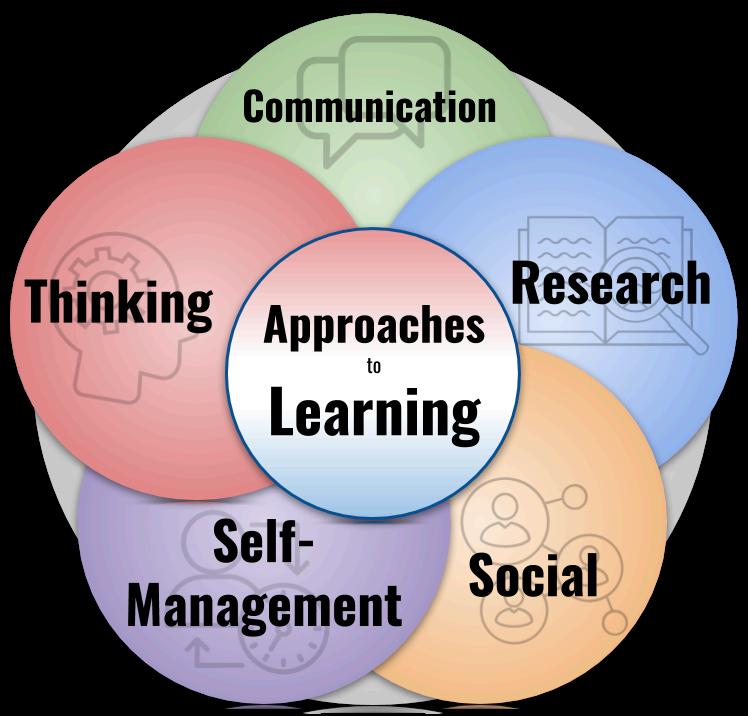

Thinking skills
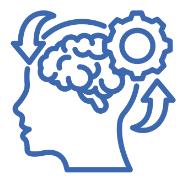
Research skills
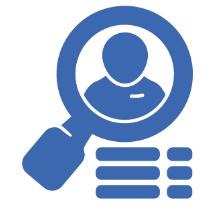
Communication skills

Social skills

Self-management skills
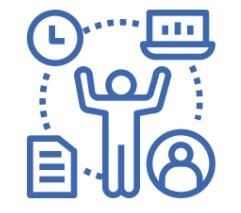
● Critical-thinking skills (analysing and evaluating issues and ideas)
● Creative-thinking skills (generating novel ideas and considering new perspectives)
● Transfer skills (using skills and knowledge in multiple contexts)
● Reflection/metacognitive skills ((re)considering the process of learning)
● Information-literacy skills (formulating and planning, data gathering and recording, synthesising and interpreting, evaluating and communicating)
● Media-literacy skills (interacting with media to use and create ideas and information)
● Ethical use of media/information (understanding and applying social and ethical technology)
● Exchanging-information skills (listening, interpreting, speaking)
● Literacy skills (reading, writing and using language to gather and communicate information)
● ICT skills (using technology to gather, investigate and communicate information)
● Developing positive interpersonal relationships and collaboration skills (using self-control, managing setbacks, supporting peers)
● Developing social-emotional intelligence
● Organisation skills (managing time and tasks effectively)
● States of mind (mindfulness, perseverance, emotional management, self-motivation, resilience)
Students at ISP are encouraged to take action as a result of their learning Action can be a demonstration of a sense of responsibility and respect for themselves, others and the environment
Action usually begins in a small way but arises from genuine concern and commitment
Action as a result of learning often happens beyond the classroom, and teachers at ISP are always keen to know about action that the students take outside of school
All IB programmes are informed by assessment, as indicated in the IB approaches to teaching While assessments look different in each programme, all IB assessment methods are varied and fit for purpose in line with ISP’s Assessment Policy
Assessment is central to the Primary Years Programme (PYP) goal of thoughtfully and effectively supporting students through the acquisition of subject-specific knowledge and skills, the understanding of concepts and the development of approaches to learning
The development of knowledge, conceptual understandings and skills requires that both teachers and students demonstrate assessment capability
Characteristics of effective assessment
Highly effective assessment shares some key characteristics (Adapted from Clarke 2012)
● Authentic: It supports making connections to the real world to promote student engagement
● Clear and specific: This includes desired learning goals, success criteria and the process students use to learn.
● Varied: It uses a wider range of tools and strategies that are fit for purpose in order to build a well-rounded picture of student learning.
● Developmental: It focuses on an individual student’s progress rather than their performance in relation to others
● Collaborative: It engages both teachers and students in the assessment development and evaluation process.
● Interactive: Assessment encompasses ongoing and iterative dialogues about learning.
● Feedback to feedforward: It provides feedback on current learning to inform what is needed to support future learning (Hattie, Timperley 2007) and raises students’ motivation
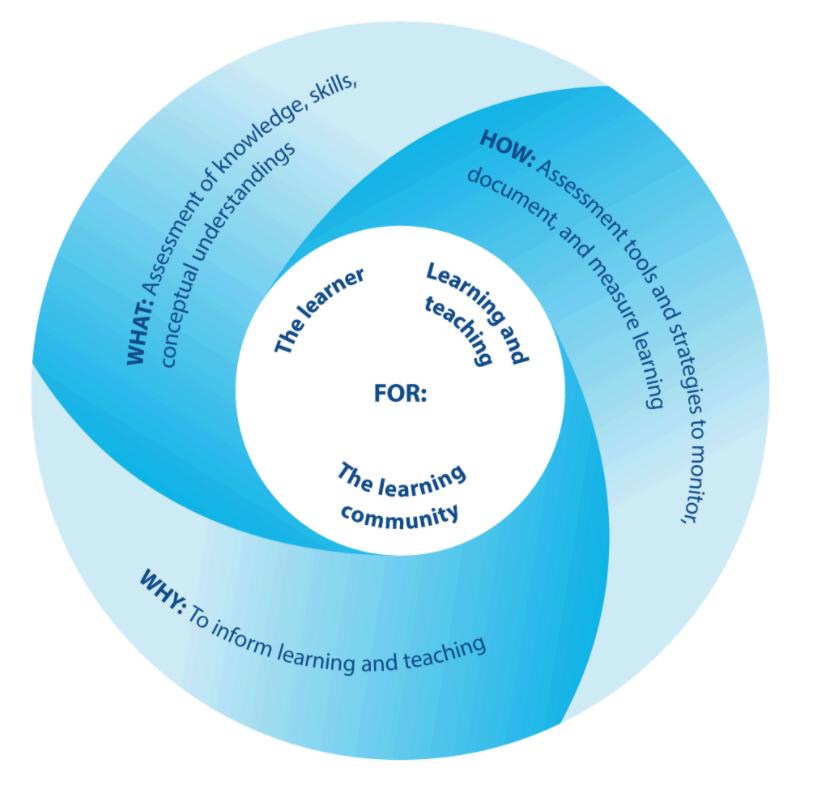


At ISP, we promote the use of a range of assessment tools and strategies that are designed to give a clear picture of a student’s prior knowledge and progress. Examples of these include anecdotal records, checklists, portfolios, continuums and rubrics.
Homeroom teachers and specialist teachers will assess each student. In addition, students are encouraged to self-assess and monitor their progress. Each student will share their assessments, including self-assessments, with their parents at regular intervals throughout the year.
Parents, teachers and students are all viewed as partners in learning Progress in learning is reported in a variety of ways: parent-teacher conferences, three-way conferences, student-led conferences, and semester reports Parents are expected to attend all of the conferences Parents are always welcome to arrange conferences at school and, likewise, the school may initiate a conference with parents at any time during the year
W all s or c
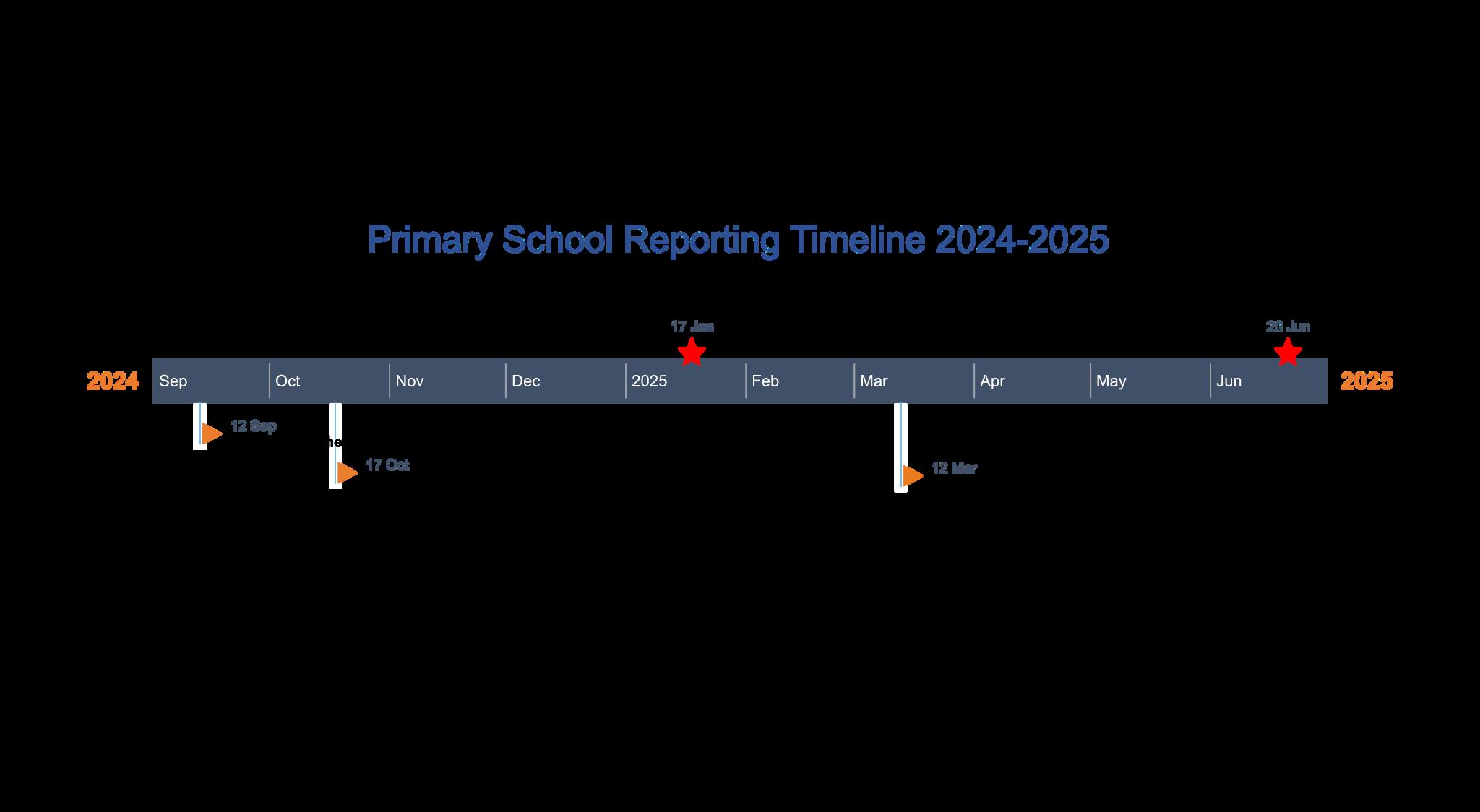
PT ny f he practices of the PYP. In September ISP Primary holds a Meet the Teachers Evening during which teachers explain the curriculum plans for the upcoming year and answer any questions you have about the grade and how it works
Parent workshops are also organised throughout the year for parents to attend and learn more about the program We do hope that you will come to parent workshops and take the time to read the regular Parent Curriculum Newsletters that can be found in the Parent Portal (https://www isparis edu/welcome-to-parent-portal) to stay informed about the PYP
At ISP, we work towards closing learning gaps and supporting students with mild learning variances Learning support staff work alongside homeroom teachers to plan for, help remediate, and differentiate for identified students Students with significant, identified learning gaps will spend time in pull-out sessions with the learning support specialist to work on these, as well as receive in-class support from the learning support specialist Students who receive this type of support are issued a written report to inform parents of their progress Identified students who need extra practice in
some basic skills may spend some time with the learning support specialist (dependent on availability) closing these learning gaps in class; this practice is exceptional and is regularly reviewed. Learning support staff are always happy to discuss students’ individual needs with parents by appointment. External referrals may be recommended to explore further clarification on students' learning variances when necessary.
Academic integrity at the Primary School means that students engage in the inquiry process as principled learners and critical thinkers who respect the ideas of others Students will develop an understanding of what academic honesty is and why it is important to be academically honest
Students will learn:
● the importance of considering different sources to explore a range of perspectives;
● the use of keywords to research efficiently;
● how to highlight, take notes, paraphrase and summarise;
● how to think critically about the validity of sources;
● how to give credit to whom and where their ideas come from by citing sources, including inspirations;
● how to write a bibliography using the agreed conventions (including the title of the source, the author, the publication date, the publisher and the website if relevant);
● how to reflect on the learning process and consider what was learned from different contexts;
● to identify primary and secondary sources;
● the difference between facts and opinions;
● what constitutes plagiarism.
We will model and foster:
● appreciation for their own work and the work of others;
● respect for different ideas;
● integrity through honesty;
● commitment to learning by showing self-discipline;
● independence in their work and thinking
Ultimately, we aim for the students to take action for themselves by applying their understanding, knowledge, skills and attitudes to take the initiative in being academically honest, and to take pride in their own accomplishments.
ISP reserves the right to use anonymised student work for its educational purposes However, a student has the right to retain full permission of his/her work (in accordance with the International Baccalaureate Organisation) and withdraw the work at any point.


We believe at ISP in Primary School that learning should be based on the student’s interest, and connect to and build on what is happening in the classroom Therefore, we offer authentic inquiry and play-based age appropriate home learning experiences alongside targeted individual learning exercises that support students who may need additional consolidation of skills and concepts
At ISP, students in their final year of the PYP (Grade 5) participate in the Exhibition that represents a significant event in the life of a PYP school and student, synthesising the essential elements of the PYP and sharing them with the whole school community. As a culminating experience it is an opportunity for students to exhibit the attributes of the International Baccalaureate (IB) learner profile that have been developing throughout their engagement with the PYP.
Parents and students from ISP are invited to attend the Grade 5 Exhibition. We expect at least one parent or guardian for each Grade 5 student to attend the Exhibition.
Language is fundamental to learning, thinking and communicating. Structured, purposeful inquiry is the main approach to teaching and learning language in the PYP, although other teaching strategies and styles may also be used Language is developed across the whole curriculum and, as a result, all teachers at ISP are language teachers, who model and teach the use of language Learning takes place in authentic contexts, and literature plays a special role in enabling this to happen
Students learn language when they are using it through speaking, listening, reading and writing in order to understand and express ideas Teachers provide opportunities for this to happen in a safe and stimulating environment in order to encourage risk-taking and learning
Our aim is to develop students’ ability to express themselves fluently, confidently and accurately in oral, written and visual communication systems
Language strands
● Oral communication: listening and speaking
● Written communication: reading and writing.
● Visual communication: viewing and presenting.
Students also learn French from Nursery to Grade 5. Nursery and Pre-K students receive French in an inclusion model in their homerooms. Students from Kindergarten to Grade 5 are grouped according to their prior experience and knowledge of the French language. At each grade level, there are differentiated groups based on the number of students in the grade level and their knowledge of French. These groups range from complete beginners to French mother tongue.

At the International School of Paris, we welcome students from around the world Our students join us with diverse cultural identities and language profiles The English as an Additional Language (EAL) department seeks to assist students in integrating into an English-speaking environment so that they feel comfortable at our school EAL teachers work alongside homeroom teachers to plan, teach and assess students’ understanding of our curriculum as they work through English language acquisition levels. In order to enable students’ confidence, skills and knowledge, EAL teachers instruct students in fundamental English skills in differentiated language lessons. Students who are new to English work through the Initiation to English unit of inquiry in small groups with the EAL teacher for the first six weeks of school.
As students begin their English language learning process, we recognize that each one of them comes to us with a wealth of knowledge and skills. We encourage students to use their home language(s) to develop English skills by using their own language(s) when appropriate. Students who are new to English are supported to understand the curriculum with specific scaffolding strategies targeted at English-language learners.
In the early stages of learning a language, learners may go through what is called “the silent period.” We respect this. As students begin to speak in English, we celebrate their courage. In the process of learning English, students will make mistakes. We recognize that making mistakes is an essential part of learning needed to develop language skills.
At ISP, we use literature from around the world to embrace the student body’s multiculturalism. English learning strategies and scaffolding incorporate the various genres of literature and connect to the current unit of inquiry studied in the homeroom at that time
EAL teachers formally report on our multilingual students' language acquisition level using the Primary School's English Additional Language continuum. The reports include observations and describe the students’ abilities within levels one through four of the four language strands addressed in the continuum. In addition, EAL teachers attend parent-teacher conferences and three-way conferences
Why Study the Home Language? Maintenance of students' home languages is extremely important Many studies show that students who continue to develop their home languages while learning a new language benefit academically, socially and emotionally
The PYP strongly recommends maintenance of the home languages for all students and so at ISP Primary School, we facilitate this by being the liaison between the home language teachers and students; and by providing appropriate spaces for the classes

In the PYP, the ever-increasing impact of Information and Communication Technologies (ICT) on teaching and learning is recognized The use of technologies is integrated as much as possible into student inquiries
ICT provides opportunities for the enhancement of learning, and may significantly support students in their inquiries, and in developing their conceptual understanding At ISP, technology is considered a tool for learning, albeit with its own set of skills, as opposed to an additional subject area
The following six ICT skills are relevant to all learners Each skill is transdisciplinary and will support learning both within the transdisciplinary program of inquiry and within the subject areas:
Investigating
Investigating is to carry out a purposeful inquiry or research, to test existing understanding, discover new information and create new understanding Through investigation, learners critically evaluate a variety of sources, making connections and synthesising findings to apply knowledge to real-life contexts
Creating Creating is a process through which learners are provided with an opportunity to innovate and test boundaries Learners construct meaning, apply critical thinking and original ideas to real-world situations, and share knowledge through self-expression, problem-posing and problem-solving, and reflection
Communicating
Collaborating
Organising
Becoming a responsible digital citizen
Communicating is the exchange of information with various audiences using a range of media and formats Effective communicators contribute to cross-cultural understanding, make informed choices when deciding on tools to articulate meaning, and provide relevant, significant feedback to others
Collaborating is the process through which learners validate and negotiate ideas and reach a deeper understanding and a global perspective Learners are empowered through digital media and environments and through active participation in creating and sharing knowledge
Organising is the ability to structure or arrange connected items. Learners understand that ICT systems can be used to inform, adapt, manage, and problem-solve during their creative, communicative, collaborative and investigative processes Learners make connections, transfer existing knowledge and independently explore new technologies
Becoming a responsible digital citizen involves using ICT to make informed and ethical choices while acting with integrity and honesty. In a globally connected digital world, learners are empowered to be responsible for their actions, to value others’ rights and to practise safe and legal behaviours
Whoweare
The library is viewed as the hub of a PYP school, in which students develop essential information and literacy skills by accessing a range of media and texts
Students will visit the library on a scheduled basis with their class once a week All students will borrow books to take home during this time Parents and students are welcome to visit the library at other times when the librarian is present
An ISP Book Bag will be issued to students at the beginning of the year This needs to be returned to the school at the end of the year
It is important that students return their borrowed books the following library session A replacement fee will be charged for any lost or damaged books or bags
The programme of inquiry is reviewed regularly and this includes the potential of changing the order of units and their focus. Below is an example of how the Programme of Inquiry looked in 2022-2023; there may be revisions once pedagogical staff have reviewed at the start of the 2023-2024 academic year. This will be communicated to parents once confirmed in the curriculum information letters sent to inform parents about each unit during the course of the school year.
Learners
CentralIdea: Our relationships helpusto learnabout ourselvesand others
CentralIdea: Playand curiosityhelp ustolearn moreabout ourselves, othersandthe worldaround us
CentralIdea: Interacting withothers helpsmeto knowmore aboutmyself andbuild relationships
CentralIdea: Developing our self-awareness canenableus tounderstand ourmotivation tolearn
CentralIdea: Conscious actionscan helpus maintainour overallhealth.

Wherewe areinplace andtime
Howwe express ourselves
CentralIdea: Different journeyshelp ustolearn aboutour world
CentralIdea: Through storytelling, wecan exploreour creativity
CentralIdea: Usingour imagination wecan expressour ideas creatively.
CentralIdea: Differenttools andstrategies helpus navigateour surroundings
CentralIdea: Interactions withartscan leadto different interpretations andspark creativity
CentralIdea: Storiesand artefacts connectusto thepast
CentralIdea: Aneffective performance involves collaboration andregular reflection.
CentralIdea: Evidence helpsus documentthe difference betweenthen andnow.
CentralIdea: Thepowerof wordsand imagescan affectour thoughtsand feelings.
Central Idea:: Recognizing similarities and differences impactshow weparticipate in communities
CentralIdea: Historical eventshave shapedour perspectiveof thepresent andfuture
CentralIdea: Acreative processcanbe usedto generateand developideas
CentralIdea: Aswegrow, weexperience changes
Centralidea: People migratefor different reasons
CentralIdea: We communicate inavarietyof waystoshare our understanding oftheworld

Howthe worldworks
Howwe organize ourselves
Sharingthe planet
CentralIdea: Thewaywe organise ourselves impactsour community
CentralIdea: Thechoices wemakein thedesign processaffect thestructures webuild
CentralIdea: Scientists investigate different forcesand howthey work
CentralIdea: Peoplerelyon eachotherfor systemsto work
CentralIdea: Throughplay, weresearch theworld aroundus
CentralIdea: Bodysystems worktogether tohelpus function
CentralIdea: Payingclose attentionto naturehelpsus tounderstand theimpactof ouractions.
CentralIdea: Thebalanceof anecosystem isessentialfor livingthings tosurvive
CentralIdea: Thechoices wemakeand different factors contributeto how successfulan eventis
CentralIdea: Ourchoices affectthe sustainability oftheEarth’s resources
CentralIdea: Organisation allowspeople tocome togetherto shareculture
CentralIdea: Humansand theearthare affectedby natural phenomena.
CentralIdea: Thescientific process enhancesour understanding aboutthe world
CentralIdea: Scientific discoveries impact decisions abouttheway welive.
CentralIdea: Ourdecisions caninfluence equal opportunities
English Language
CentralIdea: Human behaviourcan create,prevent orresolve conflict
CentralIdea: Understanding organisational structures allows individuals andgroupsto function effectively
Centralidea: Climate change impactslife andthe environment
Language is a complex web of connections that transcends the artificial separations of subjects. When the three aspects of learning language, learning about language and learning through language, operate together in a relevant context, they provide the most supportive learning environment for language learners
At ISP we develop students’ use of language, appreciation of language, awareness of the nature of language, of the many influences on language, and of the variety in and between languages and dialects Students recognize the transdisciplinary nature of language they use language within and across the subjects and in a way that transcends them, both inside and outside the classroom They should be encouraged to recognize that competency in language and in more than one language is a valuable life skill, a powerful tool both in societal communication and as a means of personal reflection Furthermore, learning that language and literature are creative processes encourages the development of imagination and creativity through self-expression
The PYP has identified three strands oral language, visual language, written language that are learned across and throughout the curriculum, with each strand being an integral component of
language learning. Each strand has been considered from both the receptive aspect receiving and constructing meaning, and expressive aspect creating and sharing meaning. While the receptive and expressive aspects are clearly reciprocal, the processes involved in receiving and constructing meaning are different from those involved in creating and sharing meaning. The learner’s ability to understand language and use it effectively varies in different situations and from one individual to another For this reason, it is important to distinguish between these two modes of learning and the demonstrated proficiencies associated with them For example, a learner may listen attentively and reveal understanding through written or visual representations, but may require support to communicate ideas orally in the classroom
The acknowledgement of both the receptive and expressive aspects of the language strands serves to ensure that teachers will be aware of the need to provide a balanced programme Opportunities to listen and receive ideas and information in oral form should be balanced with opportunities to express ideas orally In visual language, learners will view and interpret other people’s work and create and share their own presentations The interwoven receptive and expressive aspects of the oral and visual strands are represented in one continuum for each strand In written language, learners will experience reciprocal gains as they develop skills and understanding in reading and writing The strands of oral, visual and written language have been described separately, and are represented by four continuums: listening and speaking; viewing and presenting; reading; writing.
Listening and speaking are natural, developmental processes that infants and young children are immersed in from their earliest experiences Almost all children arrive at school with an impressive command of their home and family languages However, the expectations and approach to language development in school is often very different from the successful learning environment the child has previously experienced. In the transition from home to school, or from one school to another, it is important to acknowledge the language profile of the individual and build on previous learning in ways that are positive and productive.

Oral language encompasses all aspects of listening and speaking skills that are essential for ongoing language development, for learning and for relating to others Listening (the receptive mode) and speaking (the expressive mode) work together in a transactional process between listeners and speakers


Viewing and presenting are fundamental processes that are historically and universally powerful and significant. The receptive processes (viewing) and expressive processes (presenting) are connected and allow for reciprocal growth in understanding; neither process has meaning except in relation to the other. It is important to provide a balanced programme with opportunities for students to experience both viewing and presenting. These processes involve interpreting, using and constructing visuals and multimedia in a variety of situations and for a range of purposes and audiences. They allow students to understand the ways in which images and language interact to convey ideas, values and beliefs Visual texts may be paper, electronic or live, observable forms of communication that are consciously constructed to convey meaning and immediately engage viewers, allowing them instant access to data Examples of visual texts are: advertisements, brochures, computer games and programs, websites, movies, posters, signs, logos, flags, maps, charts, graphs, diagrams, illustrations, graphic organisers, cartoons and comics Learning to interpret this data, and to understand and use different media, are invaluable life skills
Reading is a developmental process that involves constructing meaning from text The process is interactive and involves the reader’s purpose for reading, the reader’s prior knowledge and experience, and the text itself It begins to happen when the young learner realises that print conveys meaning and becomes concerned with trying to make sense of the marks on the page The most significant contribution parents and teachers can make to success in reading is to provide a captivating range of picture books and other illustrated materials to share with beginning readers Enthusiasm and curiosity are essential ingredients in promoting the desire to read Children of all ages need to experience and enjoy a wide variety of interesting, informative, intriguing and creative reading materials.
Reading helps us to clarify our ideas, feelings, thoughts and opinions Literature offers us a means of understanding ourselves and others, and has the power to influence and structure thinking Well-written fiction provides opportunities for learners to imagine themselves in another’s situation, reflecting on feelings and actions, and developing empathy. The ability to read and comprehend nonfiction is essential for the process of inquiry. As inquirers, learners need to be able to identify, synthesise and apply useful and relevant information from text. Teachers should provide a balance between fiction and non-fiction, to meet the range of learning needs and interests of their students. Children learn to read by reading. In order to develop lifelong reading habits, learners need to have extended periods of time to read for pleasure, interest, and information, experiencing an extensive range of quality fiction and non-fiction texts. As learners engage with interesting and appealing texts, appropriate to their experiences and developmental phase, they acquire the skills, strategies and conceptual understanding necessary to become competent, motivated, independent readers.
Writing is a way of expressing ourselves. It is a personal act that grows and develops with the individual. From the earliest lines and marks of young learners to the expression of mature writers, it allows us to organise and communicate thoughts, ideas and information in a visible and tangible way. Writing is primarily concerned with communicating meaning and intention. When children are encouraged to express themselves and reveal their own “voice”, writing is a genuine expression of the individual. The quality of expression lies in the authenticity of the message and the desire to communicate If the writer has shared his or her message in such a way that others can appreciate it, the writer’s intention has been achieved Over time, writing involves developing a variety of
structures, strategies and literary techniques (spelling, grammar, plot, character, punctuation, voice) and applying them with increasing skill and effectiveness. However, the writer’s ability to communicate his or her intention and share meaning takes precedence over accuracy and the application of skills. Accuracy and skills grow out of the process of producing meaningful communication.
Children learn to write by writing. Acquiring a set of isolated skills will not turn them into writers. It is only in the process of sharing their ideas in written form that skills are developed, applied and refined to produce increasingly effective written communication.
The mathematics component of the curriculum of the PYP encompasses measurement, shape and number, and their many applications to students’ everyday lives Mathematics provides opportunities for students to engage in investigations into measurement, shape and number, and allows them to communicate in a language that is concise and unambiguous Mathematics concepts and skills can also be applied to solve a variety of real-life problems Students apply their mathematical reasoning to a number of situations in order to find an appropriate answer to the problems they wish to solve
In the PYP, the mathematics component of the curriculum should be driven by concepts and skills rather than by content The specified concepts are inevitably influential in driving the curriculum, but there are many other related mathematics concepts that provide further understanding of the subject
Mathematics scope and sequence identifies the expectations considered appropriate in the PYP Within each of these interconnected strands, there should be a balance between the acquisition of knowledge and skills and the development of conceptual understanding The mathematics knowledge component is arranged into five strands: data handling, measurement, shape and space, pattern and function and number
In the pattern and function and number strands, students and teachers inquire into number systems and their operations, patterns and functions They become fluent users of the language of mathematics as they learn to understand its meanings, symbols and conventions
Data handling, measurement and shape and space are the areas of mathematics that other disciplines use to research, describe, represent and understand aspects of their domain Mathematics provides the models, systems and processes for handling data, making and comparing measurements, and solving spatial problems These three strands are, therefore, best studied in authentic contexts provided by the transdisciplinary units of inquiry.


Data handling Data handling allows us to make a summary of what we know about the world and to make inferences about what we do not know.
Data can be collected, organised, represented and summarised in a variety of ways to highlight similarities, differences and trends; the chosen format should illustrate the information without bias or distortion
Probability can be expressed qualitatively by using terms such as “unlikely”, “certain” or “impossible” It can be expressed quantitatively on a numerical scale
Measurement
Shape and space
Pattern and function
To measure is to attach a number to a quantity using a chosen unit. Since the attributes being measured are continuous, ways must be found to deal with quantities that fall between numbers It is important to know how accurate a measurement needs to be or can ever be
The regions, paths and boundaries of natural space can be described by shape. An understanding of the interrelationships of shape allows us to interpret, understand and appreciate our two-dimensional (2D) and three-dimensional (3D) world.
To identify pattern is to begin to understand how mathematics applies to the world in which we live. The repetitive features of patterns can be identified and described as generalised rules called “functions”. This builds a foundation for the later study of algebra
Number Our number system is a language for describing quantities and the relationships between quantities For example, the value attributed to a digit depends on its place within a base system.
Numbers are used to interpret information, make decisions and solve problems. For example, the operations of addition, subtraction, multiplication and division are related to one another and are used to process information in order to solve problems. The degree of precision needed in calculating depends on how the result will be used.

The science area of the PYP encompasses science and its applications In the PYP, the science component of the curriculum should be driven by concepts and skills rather than by content The specified concepts are inevitably influential in driving the curriculum, but there are many other related science concepts that provide further understanding of the subject
Science Strands:
Living things
Earth and space
The study of the characteristics, systems and behaviours of humans and other animals, and of plants; the interactions and relationships between and among them, and with their environment.
Related concepts: adaptation, animals, biodiversity, biology, classification, conservation, ecosystems, evolution, genetics, growth, habitat, homeostasis, organism, plants, systems (digestive, nervous, reproductive, respiratory)
The study of planet Earth and its position in the universe, particularly its relationship with the sun; the natural phenomena and systems that shape the planet and the distinctive features that identify it; the infinite and finite resources of the planet
Related concepts: atmosphere, climate, erosion, evidence, geography, geology, gravity, renewable and non-renewable energy sources, resources, seasons, space, sustainability, systems (solar, water cycle, weather), tectonic plate movement, theory of origin
Materials and matter
Forces and energy
The study of the properties, behaviours and uses of materials, both natural and human-made; the origins of human-made materials and how they are manipulated to suit a purpose
Related concepts: changes of state, chemical and physical changes, conduction and convection, density, gases, liquids, properties and uses of materials, solids, structures, sustainability
The study of energy, its origins, storage and transfer, and the work it can do; the study of forces; the application of scientific understanding through inventions and machines
Related concepts: conservation of energy, efficiency, equilibrium, forms of energy (electricity, heat, kinetic, light, potential, sound), magnetism, mechanics, physics, pollution, power, technological advances, transformation of energy

In the PYP, social studies is essentially about people: how they think, feel and act; how they interact with others; their beliefs, aspirations and pleasures; the problems they have to face; how and where they live (or lived); how they interact with their environment; the work they do; and how they organise themselves
Social studies strands:
Human systems and economic activities
The study of how and why people construct organisations and systems; the ways in which people connect locally and globally; the distribution of power and authority
Related concepts: communications, conflict, cooperation, education, employment, freedom, governments, justice, legislation, production, transportation, truth
Social organisation and culture
The study of people, communities, cultures and societies; the ways in which individuals, groups and societies interact with each other
Related concepts: artefacts, authority, citizenship, communication, conflict, diversity, family, identity, networks, prejudice, religion, rights, roles, traditions
Continuity and change through time
The study of the relationships between people and events through time; the past, its influences on the present and its implications for the future; people who have shaped the future through their actions
Related concepts: chronology, civilizations, conflict, discovery, exploration, history, innovation, migration, progress, revolution
Human and natural environments
The study of the distinctive features that give a place its identity; how people adapt to and alter their environment; how people experience and represent place; the impact of natural disasters on people and the built environment
Related concepts: amenities, borders (natural, social and political), dependence, geography, impact, landscape, locality, ownership, population, regions, settlements
Resources and the environment
The interaction between people and the environment; the study of how humans allocate and manage resources; the positive and negative effects of this management; the impact of scientific and technological developments on the environment
Related concepts: conservation, consumption, distribution, ecology, energy, interdependence, pollution, poverty, sustainability, wealth
Arts are built into the curriculum as essential areas of learning Students are required to engage in a range of performing arts (dance, drama, music) and visual arts experiences Please note that specific arts teachers are not necessarily required, although some teachers may have specific responsibilities in the arts Issues related to school size, organisation and staffing will determine the structuring of arts components of the programme
Two common strands creating and responding have been identified that apply across the different art forms and define the critical artistic processes These intrinsically connected strands are concept-driven and have been designed to interact with each other, working together to support the overall development of the students Between each of these interconnected strands, there should be a balance between the acquisition of knowledge and skills, and the development of conceptual understanding. Students should be made aware of the inevitable links to other areas of the curriculum in order to understand the interconnected nature of the subjects, with one another and with the transdisciplinary themes.
Art strands:
Responding The process of responding provides students with opportunities to respond to their own and other artists’ works and processes, and in so doing develop the skills of critical analysis, interpretation, evaluation, reflection and communication Students will demonstrate knowledge and understanding of the concepts, methods and elements of dance, drama, music and visual arts, including using specialised language. Students consider their own and other artists’ works in context and from different perspectives in order to construct meaning and inform their own future works and processes.
The responding strand is not simply about reflecting; responding may include creative acts and encompasses presenting, sharing and communicating one’s own understanding. By responding to their own artwork and that of others, students become more mindful of their own artistic development and the role that arts play in the world around them
Creating The process of creating provides students with opportunities to communicate distinctive forms of meaning, develop their technical skills, take creative risks, solve problems and visualise consequences. Students are encouraged to draw on their imagination, experiences and knowledge of materials and processes as starting points for creative exploration. They can make connections between their work and that of other artists to inform their thinking and to provide inspiration. Both independently and collaboratively, students participate in creative processes through which they can communicate ideas and express feelings
The creating strand provides opportunities for students to explore their personal interests, beliefs and values and to engage in a personal artistic journey


At ISP we focus on 3 strands within physical education: active living, interactions and movement skills
Active living:
An understanding of the factors that contribute to developing and maintaining a balanced, healthy lifestyle; the importance of regular physical activity; the body’s response to exercise; the importance of developing basic motor skills; understanding and developing the body’s potential for movement and expression; the importance of nutrition; understanding the causes and possible prevention of ill health; the promotion of safety; rights and the responsibilities we have to ourselves and others to promote wellbeing; making informed choices and evaluating consequences, and taking action for healthy living now and in the future
Regular exposure to all kinds of physical learning experiences will enable students to make informed choices throughout their lives A balanced curriculum includes the following types of experiences
● Individual pursuits: The development of basic motor skills and the body’s capacity for movement through locomotor and manipulative skills and/or experiences; the techniques, rules and purpose of a range of athletic activities (for example, track and field, swimming, skating, skiing); recognizing a high level of achievement and how to improve performance
● Movement composition: Recognizing that movements can be linked together and refined to create a sequence of aesthetic movements. Movements can be in response to stimuli or performance elements and/or criteria and can communicate feelings, emotions and ideas (for example, gymnastics, dance, martial arts).
● Games: Recognizing the challenges presented by games; the importance of manipulating space; the categorising of games; identifying and developing appropriate skills and strategies; recognizing the importance of rules and how they define the nature of a game; modifying existing games and creating new games; teamwork
● Adventure challenges: A variety of tasks requiring the use of physical and critical-thinking skills by individuals and/or groups; challenges that require groups to work together collaboratively in order to solve problems and accomplish a common goal; recognizing the role of the individual in group problem solving.
● Health-related fitness: Recognizing and appreciating the importance of maintaining a healthy lifestyle; the body’s response to exercise including the interaction of body systems and the development of physical fitness
An understanding of our own beliefs, values, attitudes, experiences and feelings and how they shape us; the impact of cultural influences; the recognition of strengths, limitations and challenges as well as the ability to cope successfully with situations of change and adversity; how the learner’s concept of self and feelings of self-worth affect his or her approach to learning and how he or she interacts with others

An understanding of how an individual interacts with other people, other living things and the wider world; behaviours, rights and responsibilities of individuals in their relationships with others, communities, society and the world around them; the awareness and understanding of similarities and differences; an appreciation of the environment and an understanding of, and commitment to, humankind’s responsibility as custodians of the Earth for future generations.
All curriculum areas provide an opportunity to utilise the approaches to learning. The PSE component of the curriculum also provides opportunities for students to:
● reflect on the development of his/her own personal, social and physical wellbeing;
● develop and apply strategies to help manage situations of change and adversity;
● work towards achieving personal goals;
● master new skills and techniques in a variety of physical activities;
● develop strategies to improve individual and team performance in physical activities;
● understand the factors that contribute to a healthy lifestyle;
● use cooperative behaviours in order to function as part of a group or team;
● reflect on interactions with other people, other living things and the wider world;
● appreciate the interdependent relationships between humans, other living things and the environment
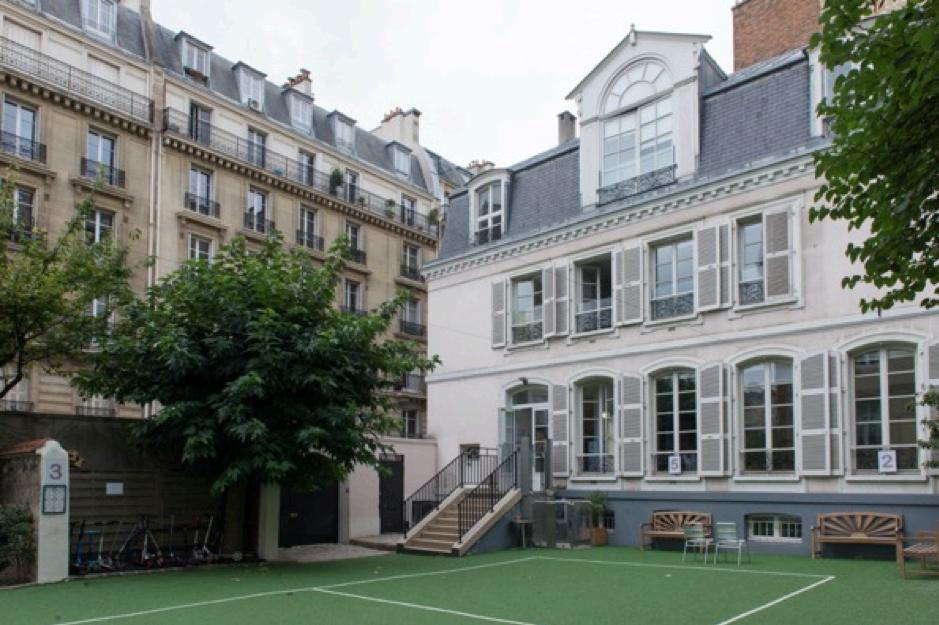
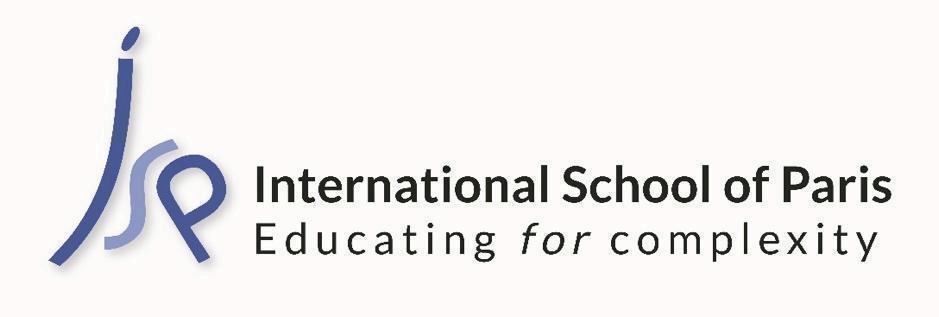
Primary School
96 bis rue du Ranelagh
75016 Paris, France
Tel: 01 42 24 43 40
Middle School
45 rue Cortambert
75116 Paris, France
High School and Main Reception
6 rue Beethoven
75016 Paris, France
Tel: 01 81 70 44 10
